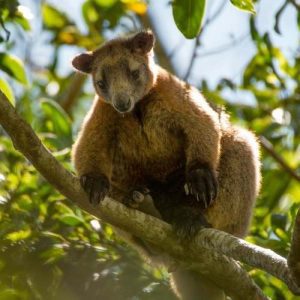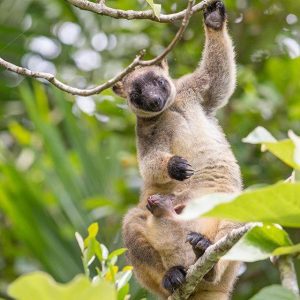Critter Corner – Tree Kangaroos
#CritterCorner – Would you believe us if we told you that there are Kangaroo’s that climb trees in the Daintree Rainforest?
Introducing the Lumholtz’s Tree Kangaroo and Bennett’s Tree Kangaroo, only found in the Wet Tropics rainforests in Far north QLD!
Tree kangaroos are very unique macropods found only in the rainforests of far north Queensland and PNG.
Australia has two endemic species, which means they live in the rainforest of far north Queensland Australia and nowhere else in the World. PNG has another 12 species.
Tree kangaroos have evolved, like all macropods or kangaroos, from tree dwelling ancestors. They are not actually related to possums. They came to the ground during evolution but as the continent of Australia moved north and dried out the bigger kangaroos moved out into grasslands and tree kangaroos returned to the trees.
It is because of this three dimensional lifestyle that they have adapted certain features that help them to climb around the canopy of the rainforest. They are in fact a macropod in every way except they have strong front legs with long claws, short back legs with short fat padded back feet to help them climb and grip in the rainforest canopy.
Tree-kangaroos are the only group of macropods that can move their hind limbs independently, that means that they can walk forwards and backwards! This helps them moving along branches and manoeuvring between branches and vines. They can also turn their ankles inwards so they can go up and down a vertical tree trunk.
They can leap to the ground from up to 10 metres up without injury. Relative to body size, the tail of Lumholtz’s tree-kangaroo (and of the other tree-kangaroo species) is the longest in the kangaroo family. It is non-prehensile (cannot be used to grip branches) and is used for balance when the tree-kangaroo is leaning out to reach leaves or moving along a branch. They are surprisingly nimble climbing around trees for a large arboreal animal.
They curl up with their tail under them between their legs when resting on a branch.
They are highly intelligent with the largest brain compared to body mass of all marsupials, which is probably due to the three dimensional lifestyle living in a complex rainforest canopy.
Tree kangaroos are difficult to spot in the forest canopy, as they are very cryptic, well camouflaged and are often high up in the canopy.
Tree Kangaroos are not social and live alone or in family groups with mother and joeys and sometimes visiting father. Joeys stay with their mothers for up to 2.5 years of age. So you may see a few joeys from previous years still with mum.
They do not “graze” on side of road nor do they eat maize in paddocks, which has been reported. These observations are mistaken identities, possibly pademelons.
Lumholtz tree kangaroos are NOT nocturnal. They are active day and night (cathemeral) and will cross roads and paddocks to find new territories if chased out by more dominant individuals.
Bennett’s are believed to be more active morning and afternoon, possible due to the higher temperatures in the Daintree rainforest than the rainforest of the Atherton Tablelands which are at higher altitude.
Bennett’s Tree Kangaroo (Dendrolagus bennettianus)

Bennett’s Tree Kangaroo (Credit: Bill Hatcher)
The Bennett’s Tree Kangaroo (Dendrolagus bennettianus) is the larger of the two tree-kangaroos endemic to Australia.
Their maximum weight is between 11-14kg when mature, body length ranges from 690–760mm and tail length can be 740–840mm long.
They are endemic to Wet Tropics rainforest in Far north Qld north of the Daintree River, found in the canopy and classified as Near Threatened (NT) on the IUCN Red List.
Bennett’s Tree Kangaroo (Dendrolagus bennettianus) are folivores (i.e. leaf-eater) – eating mostly leaves, fruit or flower off potentially more than 33 different rainforest plant species. This is why the protection of the rainforest in the Daintree is so important.
Threats include habitat loss and fragmentation resulting in tree-kangaroos being exposed to predators, and road traffic.
Lumholtz Tree Kangaroo (Dendrolagus lumholtzi)

Lumholtz Tree Kangaroos (Credit: Eclectus Images)
The Lumholtz Tree Kangaroo (Dendrolagus lumholtzi) is the slightly smaller of the two tree-kangaroos endemic to Australia.
Their average weight is between 6.3-7.6kg, with a maximum of 12.5kg for males and 10.5kgs for females, average head and body length is 450-700mm and average tail length is between 500- 800mm.
They are also endemic to Wet Tropics Rainforests in far north Qld but south of the Daintree River down to Cardwell ranges, found mostly on the Atherton Tablelands and classified as Near Threatened (NT) on the IUCN Red List.
Boongary, Muppie, Mabi are the local indigenous names on the Atherton Tablelands.
The Lumholtz Tree Kangaroo (Dendrolagus lumholtzi) is primarily a folivore (i.e. leaf-eater), eating mostly leaves from over 140 rainforest species. It also feeds on some rainforest fruits and flowers. They do not eat grass or crops as reported.
Threats include habitat loss and fragmentation resulting in tree-kangaroos being exposed to predators including domestic and wild dogs, and road traffic.
Over the past 100 years their habitat has been mostly cleared for timber and farming leaving very small patches for them to live in.
Lumholtz tree kangaroos are NOT nocturnal. They are active day and night (cathemeral) and will cross roads and paddocks to find new territories of chased out by more dominant individuals as they are very territorial.
It’s important then that people keep their pet dogs fenced in at all times or on a lead and look out for them while driving around especially the southern Atherton tablelands near rainforest.
Information courtesy of our friend Dr Karen Coombes at Tree Roo Rescue and Conservation Centre Ltd.
Want more good Rainforest news in your life?
Subscribe to our eNews | Follow us on Instagram | Like us on Facebook | Subscribe to our YouTube channel
Help Protect Rainforests Forever
Donate to Protect Rainforests Forever | Become a Rainforest Guardian for as little as $2 a month | Partnership Options

